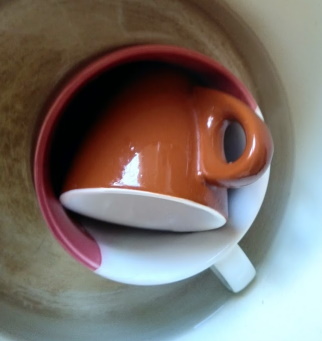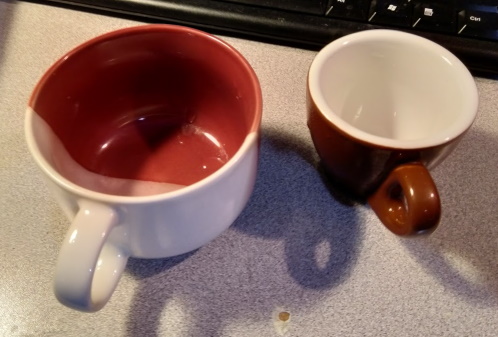My success story of the day involves two cups.
A few days ago, I heard my wife grumbling loudly in the kitchen. I went downstairs to see what was wrong. She showed me a pair of cups, a teacup, inside which there was one of our brand new espresso cups.
And when I say inside, I mean wedged inside. Firmly and utterly stuck, quite impossible to remove.

We tried to separate them using force, but they wouldn’t budge. We obviously didn’t want to break either cup. Not that they are terribly expensive but the teacup, well, we’re quite fond of these teacups and as for the espresso cup, it was brand new, I only just purchased the set off Amazon a few days earlier.
Force failed to do the trick so we tried to be clever. Use some oil to make it slick? Nope. Dishwasher detergent? That didn’t work either. I tried holding the outer cup, upside down, under hot water in the hope that thermal expansion might loosen the smaller cup inside; nope.
Nonetheless we thought that a temperature difference might help, so we filled the cups with water and put them in the freezer. Once the water was frozen solid, we took them out and placed them in a pot of boiling water. Again, the hope was that the high heat would cause the larger cup to expand, while the ice keeps the smaller cup cold, allowing it to fall out. Nope.
After this experiment failed for the third time earlier this afternoon, I sat down with the cups in hand and once again, tried brute force. The outer cup was still quite hot to the touch, the inner cup still quite cold and this may have helped; suddenly, I felt them budge, and after one more pull, they were separated, completely undamaged.

I was… absolutely delighted. Later I remarked to my wife that we humans are creatures of simple pleasures. Never mind the animations I completed just today using gravitational lenses of arbitrary shape. Never mind the work I am doing on another project on payment processor integration, or yet another project involving Microsoft Teams. (Yes, I multitask. Virtual desktops can be quite handy.) All of that is fun, sure, but it’s having been able to separate these poor cups without breaking or damaging them that really made my day.
Sometimes I’ve wondered about heating a ring of material. Surely the inner surface expands inwards, too. You need the overall expansion to be greater than the expansion from the midpoint of the wall, otherwise you make it worse. Perhaps some materials you need to heat to make the “hole” bigger, and some you need to cool to do the same thing. Time to get out the micrometer on those cups.
When the material is isotropic (same in all directions) and uniformly heated, it expands in all directions. So the cup will expand both in the perpendicular and in the tangential direction; its thickness will increase, but so will its circumference. The hole, therefore, gets bigger just the same as it would if there was no hole at all but solid material.
Not all materials expand isotropically of course. My wife mentioned things like pasta, which becomes thicker when cooked but not necessarily longer; if you use pasta-like material to form things with holes and cook them, the holes may very well shrink or even disappear.